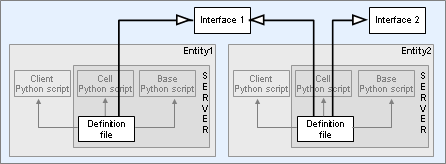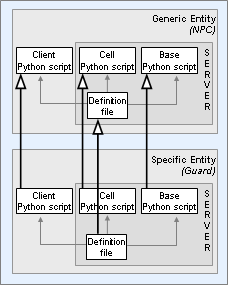Table of Contents
Class-based inheritance is a useful design technique in object-orientated software, and is implemented in most object-orientated languages.
BigWorld uses three separate classes (for the cell, base, and client
entity parts) to implement an entity, and a definition file
(<res>/scripts/entity_defs/<entity>.def
There are three different ways to declare inheritance relationships in BigWorld, all fulfilling different needs.
The Python language allows classes to be derived from each other.
For example, to define a class B, derived
from A, and methods for each of them, you can have
the code below:
class A:
def f( self ):
print "A.f was called"
class B( A ):
def g( self ):
print "B.g was called"Declaring Python class A and its
derived class B
Then suppose you have a program with the code below:
x = B() x.f() x.g()
Program using Python class inheritance
The output of this program will be as illustrated below:
A.f was called B.g was called
Example program output
When used in entities, this form of inheritance allows the sharing of common implementation details between entity types. Multiple inheritance is allowed, so that you can use many Python classes to help implement disparate features in some entities.
This concept is illustrated in the diagram and code fragments below:

Python class inheritance
The code fragments below show how the Python class
CommonBase could be used in an entity
DerivedEntity[12]
-
If a base class' cell script (
<res>/scripts/cell/CommonBase.py# note that this class is not derived from BigWorld.Entity # so it is just an ordinary Python class class CommonBase: ... def readyForAction( self ): # implement method's logic return True ... -
If a derived entity's cell script (
<res>/scripts/cell/DerivedEntity1.pyimport BigWorld from common import CommonBase ... # derive from CommonBase, so you can use the method readyForAction class DerivedEntity1( BigWorld.Entity, CommonBase ): ... def __init__( self ): BigWorld.Entity.__init__( self ) CommonBase.__init__( self ) ... def someAction( self ): if self.readyForAction(): print "action performed" ... -
Then you can call methods from the base class, as illustrated below:
DerivedEntity1.readyForAction()
BigWorld also supports inheritance in a form similar to Java's
interface system. There can be a folder <res>/scripts/defs/interfaces
This concept is illustrated below:

Python entity interfaces
The format of entity interface definition files is similar to the
format of entity definition files, except that interface definition files
do not have the section <Parent>. For more
details on entity definition files, see The Entity Definition File.
The outline of an interface definition file is described below (all sections are optional):
<root>
<Implements>
<!-- interface references -->
</Implements>
<Properties>  <!-- properties -->
</Properties>
<ClientMethods>
<!-- properties -->
</Properties>
<ClientMethods>  <!-- client methods -->
</ClientMethods>
<CellMethods>
<!-- client methods -->
</ClientMethods>
<CellMethods>  <!-- cell methods -->
</CellMethods>
<BaseMethods>
<!-- cell methods -->
</CellMethods>
<BaseMethods>  <!-- base methods -->
</BaseMethods>
<LoDLevels>
<!-- base methods -->
</BaseMethods>
<LoDLevels>  <!-- levels of detail -->
</LODLevels>
</root>
<!-- levels of detail -->
</LODLevels>
</root><res>/scripts/entity_defs/interfaces/<entity>.def
|
For details, see Properties. |
|
|
For details, see Methods. |
|
|
For details, see Methods. |
|
|
For details, see Methods. |
|
|
For details, see LOD (Level of Detail) on Properties. |
Unlike entities, entity interfaces do not need to have associated Python implementation files, although this can be a good idea.
The code fragments below illustrate the result of using an interface in an entity definition file:
-
If an entity is defined implementing an interface (
<res>/scripts/entity_defs/someEntity.def<!-- someEntity --> <root> ... <Implements> <Interface> someInterface </Interface> </Implements> ... </root> -
And if the implemented interface is defined (
<res>/scripts/entity_defs/interfaces/someInterface.def<!-- someInterface --> <root> <Properties> <name> <Type> STRING </Type> <Flags> ALL_CLIENTS </Flags> </name> </Properties> </root> -
Then conceptually, the resulting entity definition is as defined as below:
<!-- someEntity --> <root> ... <Properties> <name> <Type> STRING </Type> <Flags> ALL_CLIENTS </Flags> </name> </Properties> ... </root>
A property from an interface can be overridden if the description needs to be changed. In this case, the entire property description is replaced with the new one, so all appropriate fields need to be specified.
It is often possible to define an entity that provides functionality common to other entity types as a single base entity. For example, a collection of NPCs may share most of their implementation, but need some specific tuning to turn them into a guard or a shopkeeper.
This concept is illustrated below:

Python entity parents
The code fragments below demonstrate this form of inheritance.
-
Define the base entity
GenericEntity(<res>/scripts/entity_defs/GenericEntity.def<!-- GenericEntity --> <root> <!-- common properties and methods --> </root>
-
Define
GenericEntity's base script:import BigWorld class GenericEntity( BigWorld.Base ): ... def __init__( self ): BigWorld.Base.__init__( self ) ... -
Define
GenericEntity's cell script:import BigWorld class GenericEntity( BigWorld.Entity ): ... def __init__( self ): BigWorld.Entity.__init__( self ) ... -
Define derived entity
SpecificEntity:<!-- SpecificEntity --> <root> <!-- inheritance is defined in this tag --> <Parent> GenericEntity </Parent> <!-- add more properties and methods here --> </root>
-
Define
SpecificEntity's base script:import BigWorld import GenericEntity class SpecificEntity( GenericEntity.GenericEntity ): ... def __init__( self ): GenericEntity.GenericEntity.__init__( self ) ... -
Define
SpecificEntity's cell script:import BigWorld import GenericEntity class SpecificEntity( GenericEntity.GenericEntity ): ... def __init__( self ): GenericEntity.GenericEntity.__init__( self ) ...
There may be times when an entity type only needs to be specialised
on the server. Using the optional section
<ClientName> in a .def file allows a different (usually parent)
entity type to be used for the client entity.
For example, if NPC is derived from
Avatar, and NPC contains
additional properties that the client does not need to access,
NPC objects can be sent to clients as
Avatar objects. This means that the client does not
need a specific script to handle NPCs.
The inheritance of interfaces and parents described for entities also apply to User Data Objects. Due to the similarity of User Data Objects to regular Entities, for further details, please refer to sections Entity Interfaces and Entity Parents
For an example of inheritance in User Data Objects see
<res>/scripts/user_data_object_defs/testItem.def<res>/scripts/user_data_object_defs/testParent.def
[12] Although this example is implemented on the cell, this technique is also useful for base and client scripts.
